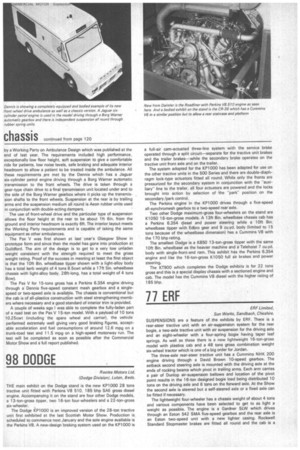chassis continued from page 120
Page 129

If you've noticed an error in this article please click here to report it so we can fix it.
by a Working Party on Ambulance Design which was published at the end of last year. The requirements included high performance, exceptionally low floor height, soft suspension to give a comfortable ride for patients, low noise levels, safe braking and adequate interior headroom to allow a patient to be treated inside the ambulance. All these requirements are met by the Dennis which has a Jaguar six-cylinder petrol engine driving through a Borg Warner automatic transmission to the front wheels. The drive is taken through a gear-type chain drive to a final transmission unit located under and to the side of the Borg Warner gearbox where it picks up the transmission shafts to the front wheels. Suspension at the rear is by trailing arms and the suspension medium all round is Aeon rubber units used in conjunction with double-acting dampers.
The use of front-wheel drive and the particular type of suspension allows the floor height at the rear to be about 1ft 6in. from the ground and interior headroom is exactly 6ft. The interior layout meets the Working Party requirements and is capable of taking the same equipment as other ambulances.
The Pax V was first shown at last year's Glasgow Show in prototype form and since then the model has gone into production at Guildford. The aim of the design is to get to a very low unladen weight consistent with the strength required to meet the gross weight rating. Proof of the success in meeting at least the first object is that the 10ft 8in. wheelbase tipper shown with a light-alloy body has a total kerb weight of 4 tons 8.5cwt while a 17ft 5in. wheelbase chassis with light-alloy body, 26ft-long, has a total weight of 4 tons 8cwt.
The Pax V for 15-tons gross has a Perkins 6.354 engine driving through a Dennis five-speed constant mesh gearbox and a singlespeed or two-speed axle is available. The chassis is conventional but the cab is of all-plastics construction with steel strengthening members where necessary and a good standard of interior trim is provided.
A couple of weeks ago I was able to complete the fully-laden part of a road test on the Pax V 15-ton model. With a payload of 10 tons 10.25cwt (including the spare wheel and carrier), the vehicle performed extremely well giving very good braking figures, acceptable acceleration and fuel consumptions of around 12.6 mpg on a trunk-road test and 11.5 mpg on a high-speed motorway run. The test will be completed as soon as possible after the Commercial Motor Show and a full report published.


















































































































































































































































































































































































